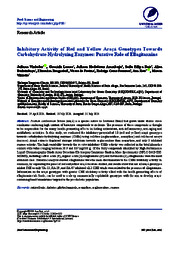Inhibitory activity of red and yellow araçá genotypes towards carbohydrate-hydrolyzing enzymes: putative role of ellagitannins.
Inhibitory activity of red and yellow araçá genotypes towards carbohydrate-hydrolyzing enzymes: putative role of ellagitannins.
Autoria: VINHOLES, J.; LEMOS, G.; AZAMBUJA, J. H.; REIS, S. F.; RUDNITSKAYA, A.; BRAGANHOL, E.; FREITAS, V. de; FRANZON, R. C.; REIS, A; VIZZOTTO, M.
Resumo: Abstract: Psidium cattleianum Sabine (araçá) is a species native to Southeast Brazil that grows under abiotic stress conditions conferring high content of bioactive compounds to its fruits. The presence of these compounds is thought to be responsible for the many health-promoting effects including antioxidant, anti-inflammatory, anti-aging and antidiabetic activities. In this study, we evaluated the inhibitory potential of 10 (red and yellow) araçá genotypes towards carbohydrate-hydrolyzing enzymes (CHEs) using cell-free (?-glucosidase, ?-amylase) and cell-based assays (sucrase). Araçá extracts displayed stronger inhibition towards ?-glucosidase than ?-amylase, and only 3 inhibited sucrase activity. The high variability towards the in vitro inhibitory CHEs activity was reflected in the total phenolics content with values ranging between 38.9 and 117 mg/100 g. Of the thirty compounds identified by High-Performance Liquid Chromatography-Diode Array Detection-Electrospray Ionization-Tandem Mass Spectrometry (HPLC-DAD-ESIMS/MS), including caffeic acids (9), organic acids (3) ellagitannins (15) and flavonoids (3), ellagitannins were the most abundant class. Statistical analysis showed ellagitannins were the main discriminators to the CHEs inhibitory activity. In summary, by expanding the panel of red and yellow araçá varieties studied, our results show that not all araçá genotypes inhibit CHE as only YA-23, RA-29, and RA-87 inhibited all 3 CHE which were related to the presence of ellagitannins. Information on the araçá genotypes with greater CHE inhibitory activity allied with the health-promoting effects of ellagitannin-rich foods, can be used to scale-up commercially exploitable genotypes with the aim to develop araçá-containing food formulations targeted to the pre-diabetic population.
Ano de publicação: 2024
Tipo de publicação: Artigo de periódico
Unidade: Embrapa Clima Temperado
Observações
1 - Por padrão são exibidas publicações dos últimos 20 anos. Para encontrar publicações mais antigas, configure o filtro ano de publicação, colocando o ano a partir do qual você deseja encontrar publicações. O filtro está na coluna da esquerda na busca acima.
2 - Para ler algumas publicações da Embrapa (apenas as que estão em formato ePub), é necessário ter, no celular ou computador, um desses softwares gratuitos. Sistemas Android: Google Play Livros; IOS: iBooks; Windows e Linux: software Calibre.
Acesse outras publicações
Acesse a Base de Dados da Pesquisa Agropecuária (BDPA) para consultar o acervo completo das bibliotecas da Embrapa.

